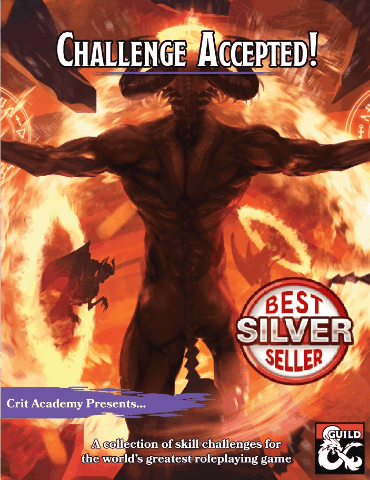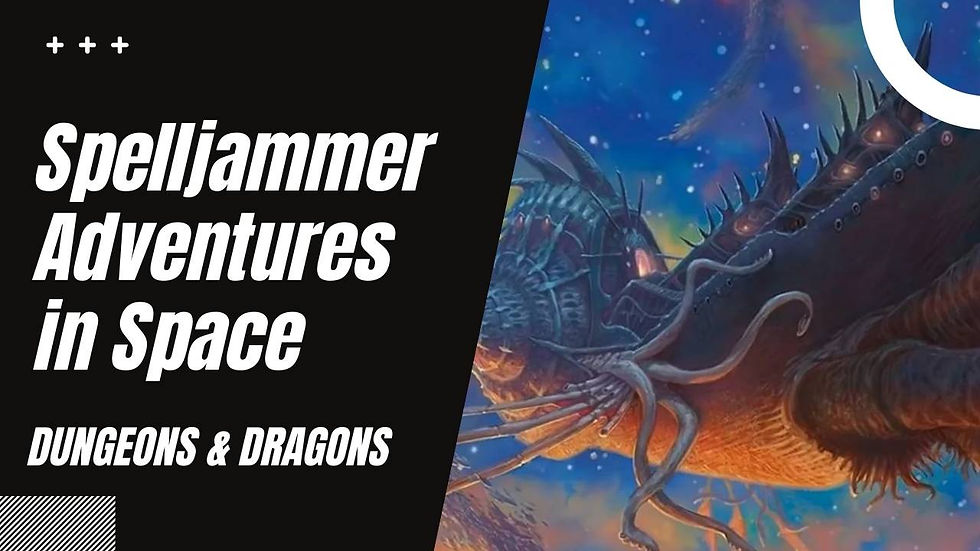Cliffhangers in Dungeons and Dragons
- Justin Handlin

- Nov 2, 2020
- 6 min read
Crit Academy discusses how the many different aspects of cliffhangers in your Dungeons and Dragons game. We also touch on how, when, and why you should use them to enhance your stories and campaigns.
What is a cliffhanger?
Is a plot device in fiction which features a main character in a precarious or difficult dilemma, or confronted with a shocking revelation at the end of an episode of serialized fiction.
Why use it?
It leaves the players wanting more. This is a great way to generate excitement and interest for the next game session. We know this works because it's pretty much the formula for countless TV shows, books and movies due to the Zeigarnik effect, which states that people remember uncompleted or interrupted tasks better than completed tasks.
Keep in mind this can be a bit tricky to set up in an RPG vs other mediums, as the entire story isn’t 100% pre-established as the players have input.
Types of Cliffhangers:
Big Reveal:
This sort of cliffhanger happens when a major plot point or twist is revealed. Probably one of the most recognizable of these is the event in Star Wars “Empire Strikes Back”, when Luke finds out Vader is his father.
Discovering that someone of importance has a different role that the heroes believed can have a huge shocking effect on them, leaving them in awe.
Action:
How about ending a session just as the PCs reach the BBEG that they have been chasing for months?
Often the most common form of a cliffhanger and easiest to set up and see coming.
Action cliffhangers leave the players n a heightened sense of excitement and uncertainty of combat.
Leaving the game ending before combat, can lead the players to spend time between next session planning and plotting on what they will do when combat starts. So be ready for any potential surprise combos!
This can be especially useful if you are running out of content that you’ve prepared, or an unintended battle is in sight.
Emotional Coaster:
Why just toy with their minds? When you can toy with their fragile emotions? The easiest way to pull this off is by attachments. Most notably and most frequent, is killing off an NPC that players have built a strong attachment or love for. Especially if this NPC has been around and helpful to the PCs for a good amount of time.
This type of cliffhanger often takes place in a moment of high tension, but, you can push it even further by placing your PC in that moment of uncertainty.
If a player has fallen in combat and is bleeding out making death saves, maybe adjust the combat so that it ends before that player finishes that death saves. Ending with them bleeding out in a moment of suspense.
Moral Ambiguity:
Players are confronted by a strong ethical or moral dilemma that requires immediate action.
(Reference Episode 15 Encounter: Time will Tell. Heroes must choose to let a child die with a known dark future.)
Ending the session before the decision can be made can torment the players on what is write and wrong until the next session. This will also give them time to get creative with their solutions and arguments for their decisions.
Make sure that the decision they must make is a big one. Allowing the potential murder of a small village is a big deal, and should weigh on them. Allowing a big bad evil village to escape to rescue an orphanage full of children, or having to choose between letting one of two good people die.
Remember that the results of these decisions could and should, have far reaching effects on the campaign, and their characters. Make sure to stress this with your players, it will make their decision that much more agonizing.
Deus Ex Machina:
Often times, heroes end up in hopeless and bleak situations, ending a session in a dark abysmal situation can be draining to the players. Adding an upswing can have a great effect on the game and players. (reference battle of helm's deep or clone wars Anakin/Amidala chained to column).
Many battles can get the players in hopeless situations, enemies storming the gate, killing allies left in right and your party is falling faster than a blond toupe in the windy city and chance of success looks nigh impossible. Then, out of nowhere a glimmer of hope, reinforcements, powerful beloved ally appears or some other slim to none chance triggers, giving a glimmer of hope appears.
Whatever the case, be sure to end the scene and session at this point before anything can be resolved.
Don’t be afraid to mix and match those different styles to give you a big whopper of a cliffhanger!
Good Cliffhangers include some of the following
Reference character backstory/backgrounds
Change the timing of a well thought out plan
Provide new and sudden inspiration
Place one or more loved ones in mortal danger
Reveal a terrible betrayal
Pervert the ending to an otherwise innocent quest (but in a fun way)
Renew an old love, hatred, stress, fear, or desire
Introduce a new villain or ally, or change an ally to a villain or villain to any ally
Change atmosphere or tone
Encourage discussion about what’s about to happen away from the table
Let something happen that everyone has wanted to happen for a long time happen, then make them wait for the next session to see the aftermath.
Unearthed Tips and Tricks! We bring you creative content for your next adventure.
Character Concept:
Lucas W.
A Hero Reborn:
This character has already experienced death. He was a simple acolyte of a small temple. The temple was under attack by monsters. This hero decided the only way to save everyone one, was to sacrifice themselves, by using themselves as a distraction. Leading the monsters away allowing the children and other villagers to escape. The gods observed this self-sacrifice, and using true resurrection, gave the young acolyte a second life. The character becomes a devout follower of the deity, thus becoming a cleric, paladin, or maybe a celestial warlock.
Monster Variant:
Cranium Burster
Origin: Giant Scorpion
New Feature:
Implantation: If the scorpion’s sting attack reduces a grappled creature to 0 hit points, or it bites a target that’s already at 0 hit points, it implants an egg in the creature’s skull through their eye socket.
The deposited egg grows for 2 tenday before hatching. If the implanted target is still alive, it loses 1 Constitution every day and has disadvantage on attack rolls and ability checks. After the first tenday, the victim is incapacitated and blinded.
When the egg hatches, a young scorpion(half all dmg and hp) erupts from the victim's head, causing 3d10 slashing damage. A lesser restoration spell can kill the egg during its incubation.
(Additionally, you can allow for a rare or special herb to do the same.)
Encounter:
The Correct Answer
Players are looking for direction to an object, or location. Only one person knows of its location. An old elderly lady. When the PCs arrive, she asks them a question before revealing the location. The party can decide as a whole, or individually.
For tension, use a timer of 10-15 seconds or count allowed.
If you answer incorrectly, she will not disclose the location.
Your answer will be simple, either number 1 or number 2.
Any other answer will be considered incorrect.
Question:
Bandits have captured your mother and your lover. You may only rescue one.
Your mother
Your lover
Who will you save?
The elderly lady then inquires to the logic behind their choice.
Regardless, of the answer the players are given a map with magical ink that as a group they can all see, or individually they each can only see their own.
The Answer: The answer is silence. Both choices are incorrect.
Regardless if the PCs pick 1 or 2, their map leads in the wrong direction into traps. But are never told they got it correct. Just…handed a map.
Additional options: Add another contestant who answers first. And is allowed to pass. But is never told if they are correct.
Magic Item:
Goldman’s Sack
This pouch is made of a soft silk, laced, and stitched with gold. A silver ribbon weaves around the outer edge, when pulled, tightly closes the pouch. On the inside of the bag is a circle with a sequence of runic sigils.
Any gold that is placed into this pouch is turned to silver permanently after 1 minute.
Once per tenday 1d4 silver pieces disappear from the sack and reappear in the creator's vault with the sacks matching sigil sequence.
Uses: great for smaller currency shops, gaining lots of silver to coat weapons, could be used to inflate the value of gold.
Dungeon Master Tip:
From @wizardonthewynd
DM tip for (hopefully) minimizing murder-hoboing. Give names to as many NPC’s as you can. Meet a town guard? Have another one, just leaving his shift for the night, call out; “night Bob, say hi to Mary and the kids for me.” Let’s see them kill ‘Bob the father’ now!
This can cause guilt as well as remind the players that the NPCs are part of a living world.
Player Tip: Don’t be a Dick
..actually, you can be a dick. To the NPC’s with Fantasy Insult Generator:
Get creative with your fighting words!
Love this app: Link below
Comes with three broad topics:
Bombastic Bombardment
Errant Slippery Gimp
Soft-toothed poxy ragamuffin
Wide-eyed bat fowling loon
Fight words
Insipid goat molester
Swag bellied goose
Slope-shouldered ninny muggins
Petty Jab
Pig-fiddler
Dewberry
Dullard
We hope you’ve enjoyed your experience here at Crit Academy. If you did, you can help others find the show by leaving a hopefully 5-star review on iTunes. Or just send us a message telling us how much you enjoy the show.
Also, be sure to give us a like and a share!
Make sure to subscribe to our show at www.critacademy.com, and Youtube so we can help you on your future adventures as well as a chance to win cool prizes each and every week. Make sure to check out our fellowship members as well.















Comments